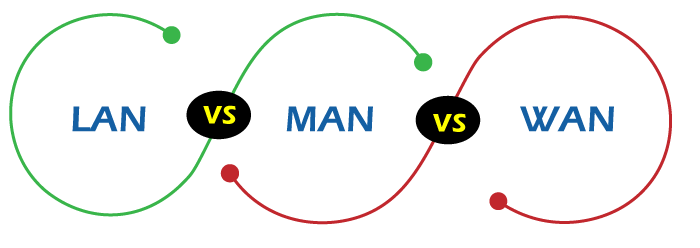Difference between LAN, MAN, and WANNetworks are very important in our lives. Be it a social network or a computer network, it is essential. Social networks are essential in building cordial relationships among family, work/ office colleagues, and friends. Social relationships are built either through personal interaction or social media. Similarly, there are computer networks that help in building social relationships. These networks depend upon the speed at which the internet is provided. All these three networks, i.e., LAN, MAN, and WAN, are used for providing internet services to people. Let us discuss about them in detail. 
LANLAN (Local Area Network) is defined as a computer network that is responsible for connecting local areas like schools, residents, universities, etc. The main function of the local area networks is to link the computers, thereby providing access to the printers, photocopies, and other services. LAN has client-server architecture. There are two types of LAN, i.e., peer-to-peer LAN and client/ service LAN. All these networks are connected to one central security database. It is interesting to note that LAN has wired networks, and all the computers and printers are connected through these wires. A LAN is used as an exclusive network for organizations, schools, universities, etc. One of the major examples of LAN is the computers in school. All the computers are connected through wires with one central database. MANA MAN, also called the Metropolitan Area Network, is defined as the computer network that joins the metropolitan areas. MAN works either through wires/ cables or modem. Telephone company network is a common example of MAN as they provide high-speed DSL line to the consumers. The main characteristic of MAN is that it is the interconnection between several links/ networks in a metropolitan area. Point-to-point connections are used in MAN. The network size of MAN ranges from 5-50 Kms. The regional sources are often shared in MAN. It is interesting to note that MAN is either owned by a group or by a network provider. Therefore, the metropolitan area network is not that expensive. The setup is quite easy, and the internet speed is relatively high. Thus, the implementation cost is saved in MAN. WANA WAN, also called the Wide Area Network, is defined as a telecommunications network that extends over a large area. The primary purpose of WAN is computer networking. The networks are linked to communicate with one another. WAN is not associated with a particular location. It helps in communication and sharing the required information among the connections. WAN is the largest network as compared to MAN and LAN. A WAN may cover a country, continent, etc. Examples of WAN include broadband services, 3G or 4G connections, etc. Some of the advantages of WAN are that it covers a larger geographical area, the software, resources, and other information is shared, has a high bandwidth, the travel charges are reduced, etc. Now, there are certain contrasting points between LAN, MAN, and WAN. So, let us have a look at them.
So, these are some of the contrasting points between LAN, MAN, and WAN. Now, there are certain features regarding LAN, MAN, and WAN. So, let us have a look at them. Characteristics of LAN
Characteristics of MAN
Characteristics of WAN
So, these are some of the characteristics of LAN, MAN, and WAN. All these three connections are widely used to connect different areas. Telephones and the internet are common examples of these networks. Thus, LAN, MAN, and WAN are essential networks that connect people, places, and countries together.
Next TopicDifference between
|
 For Videos Join Our Youtube Channel: Join Now
For Videos Join Our Youtube Channel: Join Now
Feedback
- Send your Feedback to [email protected]
Help Others, Please Share










